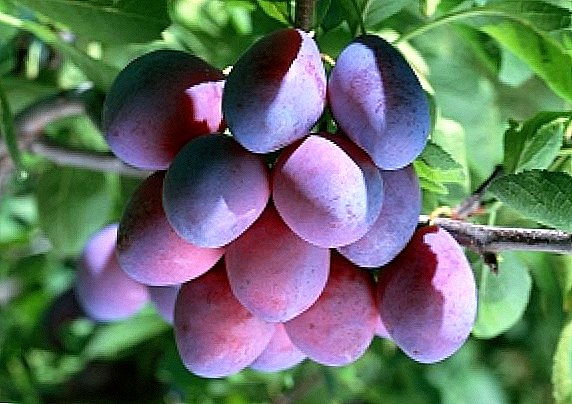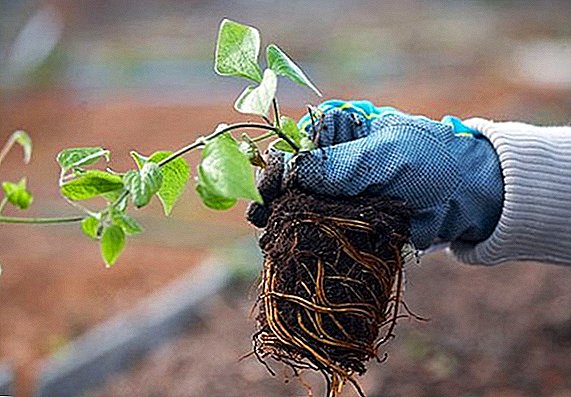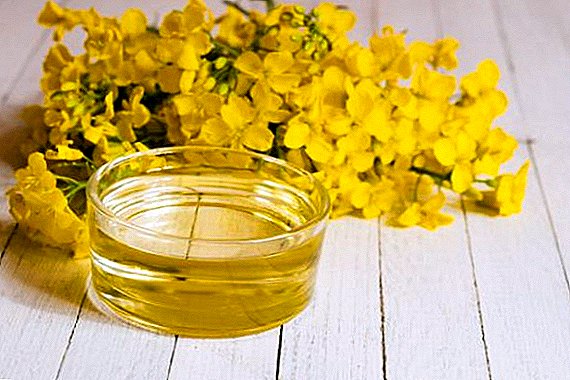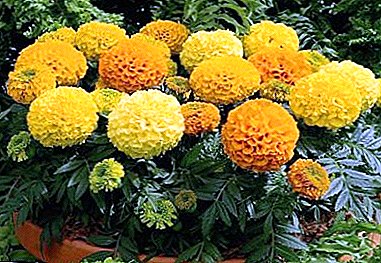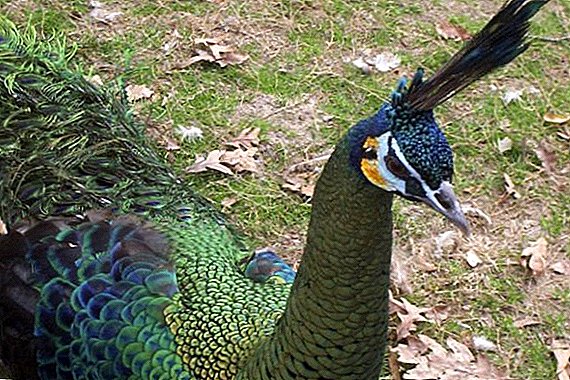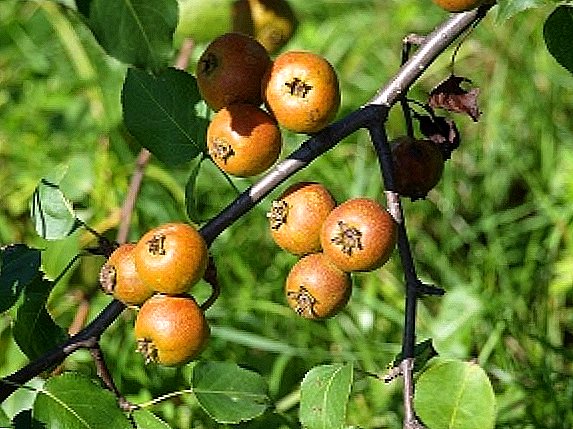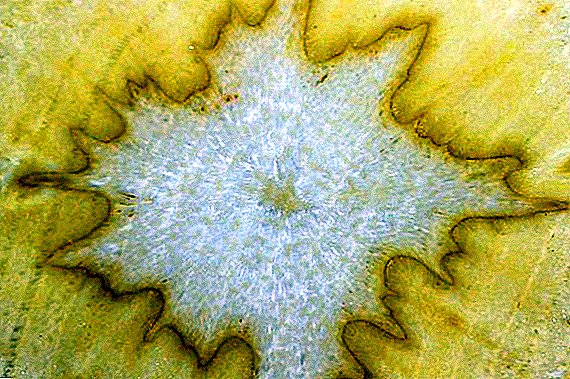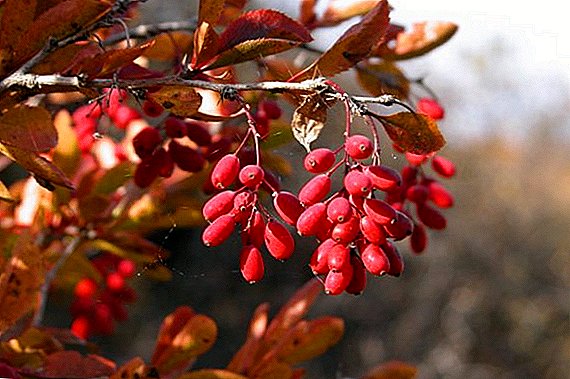 Barberry in the gardens and gardens is rare today. Gardeners are not particularly keen to deal with thorny bushes and do it completely in vain. Barberry, its beneficial properties and contraindications have been known to mankind for a long time. Among its advantages (without detracting from the rest of the qualities - decorative, melliferous, flavoring, etc.) in the first place are the healing abilities of the barberry or, as it is also called, "northern lemon".
Barberry in the gardens and gardens is rare today. Gardeners are not particularly keen to deal with thorny bushes and do it completely in vain. Barberry, its beneficial properties and contraindications have been known to mankind for a long time. Among its advantages (without detracting from the rest of the qualities - decorative, melliferous, flavoring, etc.) in the first place are the healing abilities of the barberry or, as it is also called, "northern lemon".
Did you know? There are several versions, where the name barberry comes from. One by one - from the Greek word "berbery" - a genus of shell (the shape of the leaves, the petals of the yellow flowers of the barberry resemble this shell). Another explains what a barberry is by associating the name of a plant with Berbers (the ancient inhabitants of North Africa) who brought the plant to Europe. Barberry perfectly survives in temperate and subtropical latitudes of Eurasia, Africa and America.
The chemical composition of barberry
 Barberry (Berberis vulgaris) is often referred to as "sour thorns", "kislyanka", "sour cream", etc. The unique chemical composition and, accordingly, the healing properties of all the organs of the plant. They contain:
Barberry (Berberis vulgaris) is often referred to as "sour thorns", "kislyanka", "sour cream", etc. The unique chemical composition and, accordingly, the healing properties of all the organs of the plant. They contain:
- about 11 alkaloids. The barberry produces a high content of berberine (this is its main characteristic), as well as palmitin, berberrubine, columbanine, berberine, etc .;
- flavonoids;
- essential oils;
- tannins;
- lutein;
- coumarin;
- barberry fatty oils (in seeds - 15%);
- yellow pigment (dye);
- pectin;
- vitamins (P, E, B1, C, BB, B2, carotene, etc.);
- acids (ascorbic, tartaric, citric, malic);
- fructose, glucose.
Did you know? Berberine alkaloid, found in rhizomes and other parts of the barberry, is similar in its properties to quinine, which allowed it to be used in the treatment of malaria. In 1977, D. Koshtyalova discovered that still able to treat barberry: the alkaloid contained in the stems and leaves of the shrub glaucine has a bronchodilator and antitussive effect.
What is useful barberry: healing properties
 Barberry has unique healing properties due to its unique combinations of chemical elements.
Barberry has unique healing properties due to its unique combinations of chemical elements.
Among the most valuable properties:
- soothing (has a mild sedative effect on the body);
- diuretic, diaphoretic (effectively helps with colds);
- biliary excretion;
- anti-inflammatory (effectively treats disorders of the genitourinary system);
- antioxidant (helps with poisoning, toxins, free from toxins);
- bactericidal;
- tonic and immuno-supportive;
- anti-leukemia and anti-cancer;
Did you know? The medicinal properties of barberry were used by priests and healers in ancient Egypt, India, Babylon. Old Assyrian clay tablets preserved information about how barberry was used to purify blood 2500 years ago. Avicenna recommended to heal ulcers and remove bile with the help of barberry. In the Middle Ages, hepatitis, avitaminosis, scurvy were treated with this plant. Since the 16th century, the barberries are beginning to be purposefully grown in England, France, Sweden, Italy.
Does the barberry apply in official medicine?
 Healing abilities of a barberry are adopted by doctors of many countries. Barberry is popular: drugs with it are widely produced in Italy (stomach treatment, spleen tumors), India (from diseases spread by mosquitoes), Japan (anticancer drugs), Great Britain, China and the USA (from internal hemorrhages, hemorrhoids, etc.).
Healing abilities of a barberry are adopted by doctors of many countries. Barberry is popular: drugs with it are widely produced in Italy (stomach treatment, spleen tumors), India (from diseases spread by mosquitoes), Japan (anticancer drugs), Great Britain, China and the USA (from internal hemorrhages, hemorrhoids, etc.).
In our pharmacies there are:
- medicine made from barberry bark, - "Berberine bisulfate" (pack contains 50 tablets). Hepatitis, cholecystitis and others are treated with this time-tested and affordable biliary agent;
- "Choleletin" 1, 2 (48% tincture containing barberry extracts) - help with cholelithiasis;
- barberry tinctures (20%, 5%) - made from the leaves of the plant. They help to stop internal bleeding, regulate pressure, improve the function of the liver and heart muscle;
- collection Zdrenko (for the treatment of genitourinary papillomas);
- homeopathic preparations (granules "Chole-Gran", "Uro-Gran", "Psyorizer").
The use of barberry in traditional medicine
 The plant itself barberry and medicinal drugs made on its basis, have found wide application in traditional medicine. The use of natural products without artificial chemical additives allows harmless to the body to provide effective assistance.
The plant itself barberry and medicinal drugs made on its basis, have found wide application in traditional medicine. The use of natural products without artificial chemical additives allows harmless to the body to provide effective assistance.
Important! Barberry is a carrier of rust spores (Russia graminus Pers.) On crops (mainly cereals and fodder). Exaggerate the danger is not worth it - the threat of infection is relevant only under the condition of the immediate proximity of crops to shrubs.
Barberry leaves decoction for ulcers and nausea
The tool is prepared from dry leaves. A glass of water will require 20 g of raw materials. Chop the leaves, place in a container. Pour cold water. When it boils, reduce the heat and cook the broth for another 15 minutes. Insist at least 40 minutes. When cooking, some of the water will evaporate, so boiling water can be added. Take a tablespoon three times a day.
Barberry fruit decoction as a febrifuge
 For 200 ml of broth, you will need 40 g of dry berries (before brewing the barberry, it should be chopped), boil and boil for half an hour. Strain and pour boiling water (bringing the volume to 200 ml). Drink medicine before meals in 50 ml.
For 200 ml of broth, you will need 40 g of dry berries (before brewing the barberry, it should be chopped), boil and boil for half an hour. Strain and pour boiling water (bringing the volume to 200 ml). Drink medicine before meals in 50 ml.
Barberry roots decoction for hepatitis
For the broth will need half a teaspoon of dried ground raw materials. Boil the roots in water (200 ml) and cook for half an hour. Take one teaspoon three times daily.
Did you know? In ancient Greece, the barberry was grown in gardens - people believed that the bush brings happiness to the house. Arabs add grated barberries to lovers' dishes - this should have increased passion and attraction. In 2008, scientists in Italy were able to prepare a preparation from a plant that is not inferior to Viagra.
Decoction of the roots for inflammation of the gums
Barberry root well eliminates inflammation in the oral cavity - treatment is carried out by rinsing decoction. For best effect, rinse alternately with decoctions of the roots and bark. Cooking them the same. It is necessary to pre-chop the raw material (1/2 teaspoon per 200 ml), boil. Boil for 30 minutes, add water (instead of evaporated) and strain. Rinse the mouth several times a day.
Barberry leaf tincture for kidney and liver diseases
 Dried leaves (10 g) chop, pour a glass of boiling water, hermetically close, soak in the bath for 20 minutes.
Dried leaves (10 g) chop, pour a glass of boiling water, hermetically close, soak in the bath for 20 minutes.
Cool gradually (about an hour). Strain, if necessary, top up with boiled water. Drink the medicine four times a day, 50 ml.
Infusion of the cortex in gout
One and a half tablespoons of bark should be placed in an opaque glass container, pour 100 ml of alcohol, cork and put in the dark for 14 days. Strain. Store in a cool place, protect from light. Take the drug should be a month and a half to 20-30 drops three times a day. It is necessary to conduct two courses of treatment per year (with a break between them).
Important! All medicines from barberry should be made only in enamel, glass or ceramic dishes.
How to use barberry in cosmetology
Speaking about what else is needed barberry, it is necessary to add that natural barberry means can effectively care for the skin, hair, etc. This thorny shrub is often used by cosmetologists for the production of cosmetics (tonics, creams, shampoos, etc.). In folk cosmetology for the procedures of the barberry make decoctions:

- anti-dandruff. Boil two tablespoons of dried fruit in 200 ml of water. After straining and cooling, use after washing the hair with ordinary shampoo - rub into the scalp;
- hair rinse conditioner. A decoction of leaves and fruits is perfect for dry hair and scalp care (prevents fragility, irritation and inflammation of the scalp, relieves itching). Suitable dried or fresh berries and leaves of barberry. In an enamel bowl, brew the raw material with boiling water and leave for 40 minutes. Duration of treatment - a month (with regular rinsing of hair after washing the head);
- for cosmetic ice. Daily rubbing with a cube of frozen broth rejuvenates and tones the skin, cleanses it from acne, lightens age spots, smoothes wrinkles;
- for whitening skin and removing freckles on the face and hands. Lotions are made from the decoction; baths are made for the hands.
- rejuvenating Four tablespoons of fresh berries to grind to a state of mashed potatoes, mix with a spoon of sour cream, oatmeal and medium grated apple. Apply the mask on face and after 10 minutes wash it off with brewed green tea;
- nutritious. The mask of fresh berries (glass), oatmeal (half glass), eggs, a teaspoon of honey and half a glass of hot milk effectively acts. Pour milk into oatmeal (to swell), chop the berries, mix everything. Rinse off after 15 minutes.
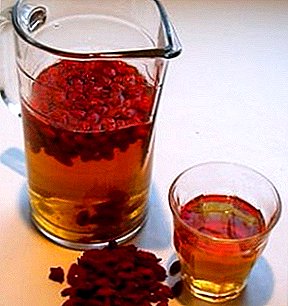
Leaves pour 120 ml of alcohol and for two weeks placed in darkness and coolness (before acquiring a brown tint and acid).
The course of treatment is 30 drops after a meal (three weeks).
The use of barberry in cooking
Barberry as a food is used everywhere, and its use in cooking has a long tradition. Caucasian and Central Asian cuisine make traditional seasoning for pilaf and shurpa from its berries and leaves - the cooking process is accelerated, the dishes get a pleasant aftertaste. Barberry found wide application in the manufacture of confectionery products (syrups, jellies, sweets, marshmallows, etc.). Barberry is made from:
- syrup. After thoroughly washing the berries, boil them to a state of mashed potatoes. Strain, add sugar (1: 1) and cook for another 10 minutes (constantly removing the foam). Hot syrup closed in sterilized jars;
- the juice. After squeezing the juice, it is poured into clean cans and pasteurized (15 minutes - a liter jar), then sealed.
The juice is rich in all those than the useful barberry. Subsequently, the juice is diluted, other beverages are prepared from it;
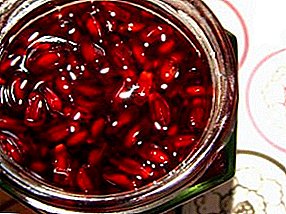
- jam. Fill the fruits with sugar (1: 1) and hold for 12 hours. Simmer for 20 minutes. Hot jam pasteurized in jars for 30 minutes;
- seasoning to meat and fish. A kilogram of berries to boil, rub through a fine sieve. 250 g of sugar and spices (cinnamon, cloves, basil, ginger, etc.) are added to the resulting mass. Boil until thickened;
- barberry tea. Tasty and fragrant, has many beneficial properties, tones. Brewed 1 tsp. dry barberry berries in 200 ml of boiling water, infused for 8-10 minutes. Sugar is added to taste.
Did you know? In the 19th and early 20th centuries, in late autumn, barberry kvass, strong vinegar (diluted with water and drank) were prepared from barberry in Moscow from the barberry. Especially valued as a good seasoning for food pickled barberry - berries poured sugar-salt syrup with vinegar and spices.
Barberry and its yellow flowers (with a very peculiar and not quite pleasant smell) is valued as a wonderful honey plant. Barberry honey has a golden color, rich taste and delicate aroma. In addition, many medicinal properties of barberry are stored in it, and this honey is rightfully known as medicinal.
Harvesting and storage of raw materials
 Of great importance is the correct collection and storage of raw materials. The barberry is a rather thorny shrub, so it is necessary to properly equip yourself before gathering - thick gloves, closed clothes with long sleeves and so on. Terms of preparation for different parts of the plant are different:
Of great importance is the correct collection and storage of raw materials. The barberry is a rather thorny shrub, so it is necessary to properly equip yourself before gathering - thick gloves, closed clothes with long sleeves and so on. Terms of preparation for different parts of the plant are different:
- Stocking the roots held in April or November (during the rest period). The amount of excavated roots should not exceed one third of all plant roots (re-harvesting of the roots of the same plant is possible at least five years later). The roots are cleared of soil, rotted or blackened areas. It is categorically impossible to wash - the berberine is washed.
- Fruit collected in September-November. Only mature fruits of barberry can be harvested - they have the most pronounced beneficial properties (immature or greenish berries contain many alkaloids).
- Bark harvested in April and May. In the spring, it is easily removed from the shoots (with the help of longitudinal and transverse cuts).
- Leaves (whole, not damaged by diseases or pests) are collected by hands (tearing, as a rule, young tops with leaves) in May - June.
Collected raw materials are dried: decomposed into a single layer under a canopy (or in dryers) with good air ventilation. A sign of the readiness of the fruit - non-clotting berries, if you take a handful with your hand Dried roots properly have a lemon color on a break, a faint smell and a bitter aftertaste. Dry raw materials are stored in cardboard boxes, paper or linen bags for no more than two years (roots are three years).
Contraindications and harm from the barberry
 Improper use of barberry can lead to serious and even irreparable consequences - its useful and dangerous properties are often interrelated. So, the ability of the plant to stimulate muscle activity is very useful for women in the postpartum period (increase the contraction of the uterus), but can lead to miscarriage if you take barberry during pregnancy. Contraindications include:
Improper use of barberry can lead to serious and even irreparable consequences - its useful and dangerous properties are often interrelated. So, the ability of the plant to stimulate muscle activity is very useful for women in the postpartum period (increase the contraction of the uterus), but can lead to miscarriage if you take barberry during pregnancy. Contraindications include:
- age less than 12 years;
- complex forms of hepatitis;
- pregnancy and breastfeeding;
- cirrhosis of the liver;
- bleeding during menopause.
Important! When treatment with barberry, you should consult a doctor - a high content of berberine can damage the liver. Using the immature fruits of barberry is life threatening - they are poisonous.






